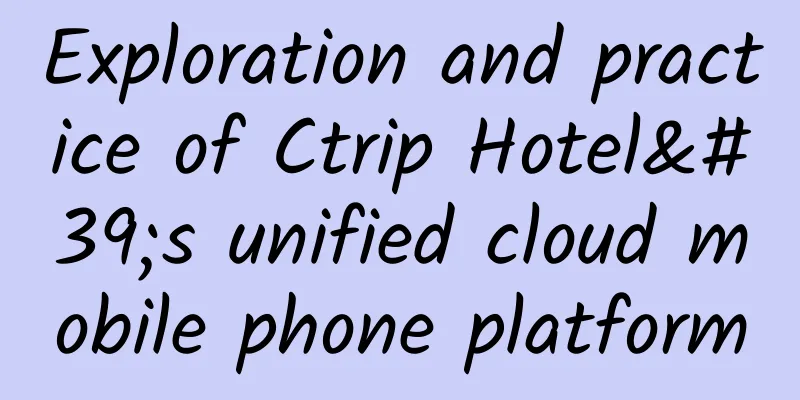Exploration and practice of Ctrip Hotel's unified cloud mobile phone platform

|
About the Author The hotel wireless performance R&D team is responsible for the research and development of the hotel wireless team's basic capability platform, such as the Cloud Touch platform (cloud mobile phone), content operation platform, automated testing process, etc. It provides solutions through abstract summaries of daily regular affairs to improve the overall efficiency of the business carried by the platform. 1. BackgroundThere are a large number of departments or teams within Ctrip that need to complete all functional tests in the R&D phase of the new version of the App and the new site, and then conduct unfettered acceptance from the customer's perspective (such as competitive product comparison, localization experience, etc.) in the pre-release phase. For the versions that have been released, our customer service staff also have the demand to use production resources to obtain the same perspective as the customer in occasions such as customer assistance and new employee training. This poses a huge challenge to the applicability of the existing test environment in our R&D process. Whether in terms of operating experience or resource alignment, the test environment is difficult to meet the requirements.
2. Full-Scene ConstructionAfter comprehensively evaluating similar demands and the possible impact of platform capabilities, the following figure shows our expectations of the applicable population of the system (hereinafter uniformly named Cloud Touch): Take the on-site acceptance scenario as an example: Based on the Cloud Touch platform, the equipment management of the acceptance personnel can be unified, and a unified remote operation portal can be provided through the cloud platform. In this way, no matter where our employees are in the world, they can conveniently use the centrally maintained equipment. At the same time, the RC package of the new site will be put on the Cloud Touch in advance to complete the deployment of the version to be accepted. Take the customer service assistance scenario as an example: based on the customer service workbench, employees are provided with a unified entrance to Cloud Touch, which allows employees to understand the corresponding App version of the guest during the conversation with the guest, and can quickly select the relevant preset real machine in the device pool for scenario identification. (Schematic diagram above) 3. Technical solutions based on Cloud Touch3.1 Core Platform DesignBased on the above analysis, the platform needs to solve the allocation and management of device resources covering different application scenarios, realize the centralized distribution of requests from different regions, provide remote control of local devices and real-time synchronization of images, so as to achieve an interactive experience similar to that of a remote desktop. And based on the platform's integration capabilities, it can provide unified preset parameters and environment configurations for different business scenarios, so that the standardization of various tasks can be further improved. 3.2 Equipment pool designWe have a large number of customer service staff seats, as well as test acceptance personnel in the R&D line. A large enough device pool is a hardware condition, but how to effectively use these devices and coordinate the relationship between people and devices in different application scenarios requires a set of allocation strategy designs that meet the core scenarios. The main core processes are as follows: 3.3 Design and implementation of remote device controlAfter achieving platformization and unified distribution of equipment, the core of the technology lies in how to select and implement an end-to-end remote control solution. Because the docking technologies of different systems are different, we take the implementation of iOS as an example here. WebDriverAgent is a new iOS mobile testing framework (WDA) launched by Facebook at the 17th SeleniumConf conference. WebDriverAgent implements a WebDriver Server on the iOS side to interact with the browser. Its implementation uses the classic Server-Client architecture (C/S). The client sends a Request and the server returns a Response. With the help of this Server, we can remotely control iOS devices. WDAClient : A client of WDA based on WebDriverAgent. facebook-wda is the Python client library of WDA, which communicates directly with WebDriverAgent by directly constructing HTTP requests. WDAServer : The machine that runs the WDA App and implements the WebDriver communication protocol. Session : The server needs to maintain the client's session. The first request sent by the client is '/session/sessionId/url'. The server opens the corresponding URL address according to the URL, and parses the sessionId into a real value, and then returns it to the client. When the client sends a request to the browser in the future, it will carry the session value. WebElement : An object in the WebDriverAPI that represents a DOM element on a page. JsonWireProtocol : It is a web service protocol that communicates with the remote server by using webdriver. It completes the interaction with the remote server through http requests. Mobile JSON Wire Protocol Specification : Mobile automation protocol. (Some basic technical descriptions of WDA official are quoted here. If you are interested, you can refer to the Facebook archive project on GitHub for further information) 3.3.1 Instruction Set Adaptation The client can receive many different types of instructions to complete different actions, mainly including the following: (1) Basic command communication format (iOS/Android share the same format, but the processing is slightly different. The following uses iOS as an example): (2) Basic instructions: mouse events (click/slide operations)
(3) Basic instructions: key events
(4) Complex script instructions
3.4 Design and implementation of remote screen synchronizationRegarding the synchronization of the images, let's first talk about the well-known ffmpeg, which is an open source cross-platform audio and video processing tool that can be used for a variety of audio and video operations such as recording, conversion and streaming media processing. We capture frames, process the data through ffmpeg, and then transcode it to h.264, and push the encoding information to the web-side live broadcast service. The current 30s video is about 30M, and after h.264 transcoding, it is only 3MB. The image stream is currently set to 20 frames per second. 3.4.1 Screen capture iOS device screen capture process: (1) WDA mjpegServer WDA comes with mjpegServer, which will continuously call the screenshot API, compress the screenshot data, assemble it into the mjpeg data stream format and send it to the port of the screen stream. (2) Screen capture speed/compression quality parameters WDA mjpegServer can set the screenshot speed and compression quality through parameters. According to the server performance and usage scenarios, adjust FBMjpegServerScreenshotQuality and FBMjpegServerFramerate to get the best effect. The human eye perceives the number of frames at around 24, so we set FBMjpegServerFramerate to 24 so that users will not feel any lag when using it (the selection of frame rate is described in the fourth section of 3.4.2) (3) Client screen acquisition When the user starts using it, a screen initialization command will be generated and sent to the Client. The client can obtain a continuous mjpeg image stream by requesting the image stream port through GET. The obtained picture stream data format is a series of mjpeg pictures separated by --BoundaryString, and each picture can be saved as a jpeg picture separately. 3.4.2 Streaming Media Processing iOS screen stream to video stream process: The client mentioned above can get jpeg images one by one through GET request to the image stream port. mjpeg is intra-frame coded and the data is very large. If the image stream data is pushed directly to the server, the bandwidth requirement for the user will be very high, so it needs to be converted to h.264 inter-frame coding. (1) Client requests the image stream port and captures the image frame by frame Request the picture stream port through ffmpeg and grab each jpeg picture through the decoder. (2) H.264 encoding Pass each captured jpeg image to the ffmpeg encoder, set the parameters, encode it in h.264 and output it to standard output. Supplement: The frame rate settings of the decoder and encoder need to be slightly higher than the screenshot speed set by WDA to ensure that the picture response is always real-time. (3) Pushing the stream to the streaming server We used the streaming server provided by the multimedia group of the framework architecture R&D department of the platform R&D center. By introducing the JAR package provided by the framework team, we can easily push the data to the server. Each frame of the ffmpeg encoder's standard output is sent to the streaming server using the device's primary key on the platform as a unique identifier. After receiving the data, the company's streaming server will generate a playback address similar to the live broadcast room based on the unique identifier. The front end can see the mobile phone screen by accessing the address. (4) Streaming bitrate We need to select the appropriate frame rate and bit rate to achieve a balance between video smoothness and clarity: Taking the bit rate upper limit as 4.5 Mbps as an example, the peak network speed required by the user end is about 550 KB/s. Required bandwidth (KB/s) ≈ Maximum streaming bitrate (bps)/8/1024. Because the user's operation speed is not very fast, the bandwidth occupied will be less. The bandwidth required for screen changes caused by general operations is about 150-200KB/s, while the bandwidth required in the static state is only 5-40KB/s. Taking all aspects into consideration, we added appropriate key frames based on the WDA screenshot speed of 24, set the Client streaming frame rate at 30 frames/s, and set the bit rate upper limit to 4.5mbps. The actual bandwidth occupied is about 350KB/s, and the picture display is smooth, clear, and without screen distortion. The maximum download speed of the WIFI we use is about 7.5MB/s, so the streaming bitrate and bandwidth are not bottlenecks. The bottleneck is mainly the efficiency of ffmpeg in converting image streams into video streams. Through calculation, the transcoding efficiency of the client-side java single-threaded ffmpeg is about 40 frames per second, which can be improved through technical optimization. 4. Data CollectionAs a basic platform that employees of related jobs will rely on to carry out their daily work, its stability must be detectable in all dimensions. It not only needs to support the monitoring of the health of the daily operation of the system, but also support the collection of sufficient operating data to provide it to platform R&D personnel for analysis and promote subsequent iterations. Platform stability : Improve user-perceived stability through various monitoring dimension data and logs; Usage detection : used to evaluate the amount of users’ reliance on the platform to work, and the impact of later platform iterations on users; V. Practice SummaryIn the field of automated testing, including Ctrip, there are actually many UI automated testing solutions that use similar technologies, and even use the same technical base. For example, the WDA framework is a new iOS mobile testing framework launched by Facebook. Coincidentally, after our team initially implemented some technical functions, we also focused on promoting them in testing scenarios. However, Ctrip's business scope is very broad. We not only have development and testing scenarios, but also content verification scenarios. In particular, we are at the forefront of internationalization, and a large number of overseas employees also have to participate in many acceptance links. Then, synchronization or training of colleagues in different countries on application versions, parameter configuration, environment initialization, and resource preparation is quite labor-intensive and costly, and the effect is not good. Based on our in-depth analysis and evolution of technology and platforms, we found that technology actually has a wide range of applications. After a basic technology platform is established, it is easy to integrate scenarios, personnel, equipment, and configurations. Many communication costs can be directly reduced, and the problem of underutilization of acceptance equipment has been well solved, especially the discovery and resolution of common problems have become efficient. In our subsequent work, we will continue to optimize the following aspects based on the current experience:
Ultimately, the platform experience can completely replace actual machine operations, allowing our potential users to personally feel that using the platform is more convenient and efficient than doing various tasks on their mobile phones. |
>>: Difference between FragmentPagerAdapter and FragmentStatePagerAdapter
Recommend
WeChat’s public reading and like counts, what has changed?
Recently, WeChat official accounts are planning t...
Affected by the epidemic, domestic smartphone shipments in Q1 may drop by 30%
The ongoing outbreak of the novel coronavirus is ...
The deeper the sleep, the better the quality of sleep? How important is it to have a good night's sleep?
In October 2020, survey data from the China Sleep...
What are the functions of the mother and baby WeChat applet? How much does it cost to develop a WeChat mini program?
As a typical representative of the market segment...
How come the woodpecker doesn't get a concussion after pecking 12,000 times a day?
Recently, Woodpecker has become popular on the so...
How to leverage Halloween? Combining 14 cases including Durex, Gucci, Ele.me, etc., we will teach you step by step!
Halloween is coming~~ The KFC posters downstairs ...
The pitfalls and tips of Android development
1. android:clipToPadding This means whether the d...
How to leverage the Apple Store to promote your own App?
In addition to delivering a good product, how can...
Why Fuzhou?
Fuzhou The capital city of Fujian The place lives...
Lanzhou mini program production and customization development, what are the processes for developing a mini program?
After the fifteenth day of the first lunar month,...
Microsoft is considering porting UWP apps to Java: Android can also use it
[[278295]] During the long holiday, Microsoft rel...
Nearly 100 executives changed in half a year. When will the intensive personnel adjustments in the automotive industry end?
In recent years, as the scale of China's auto...
Sunbathing can make you taller, so why are people in the south generally not as tall as people in the north?
It is said that sunbathing helps to grow taller, ...
Why do iPhones often break down in low temperatures? It turns out it’s not Apple’s fault
Recently, there have been many discussions about ...









